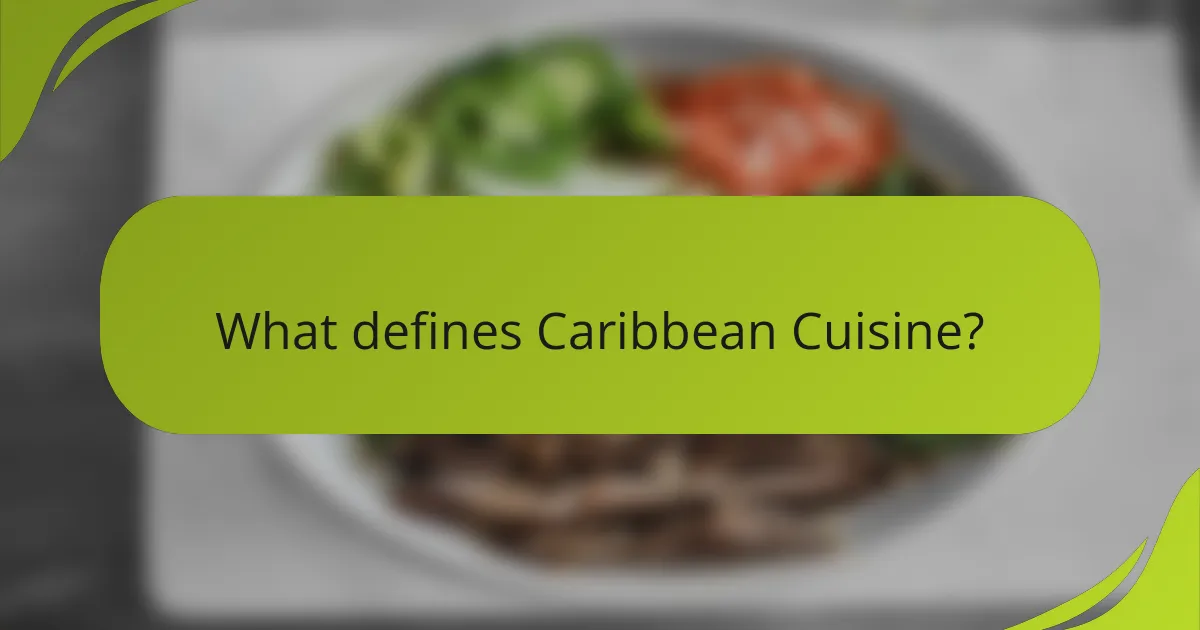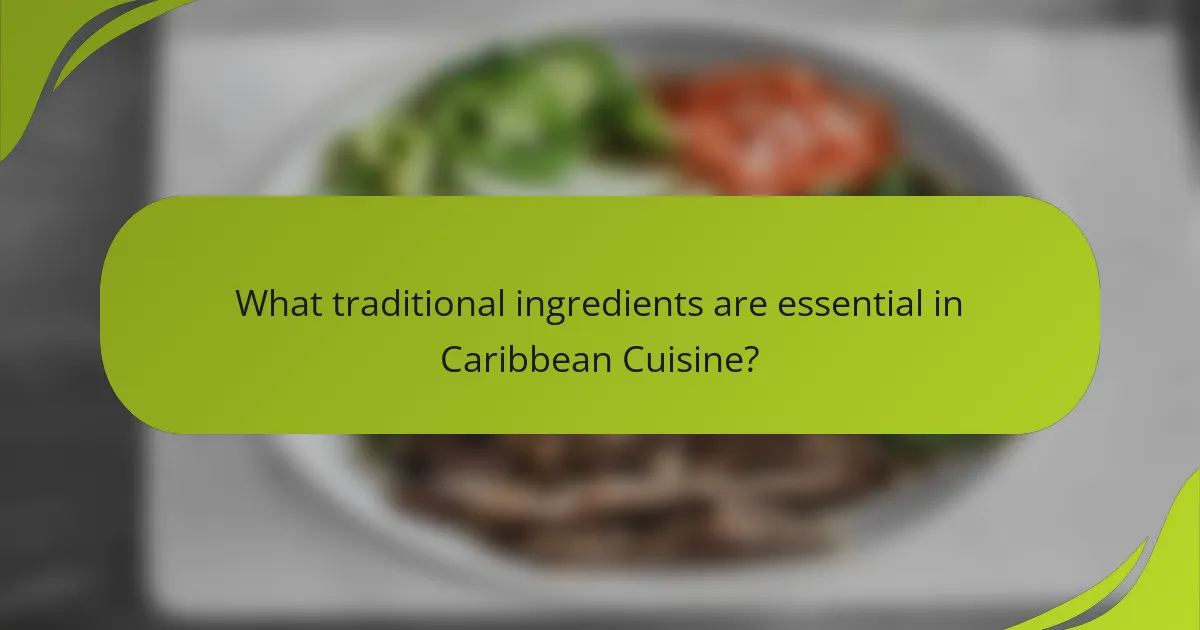Caribbean cuisine is characterized by its vibrant flavors and diverse ingredients, influenced by African, European, and Indigenous cultures. Key components include staples such as rice, beans, and plantains, alongside a variety of spices like allspice, thyme, and Scotch bonnet peppers. Cooking methods frequently involve grilling, frying, and stewing, resulting in traditional dishes such as jerk chicken, rice and peas, and ackee and saltfish. The article explores the unique flavor profiles, essential ingredients, and cooking techniques that define Caribbean culinary traditions, emphasizing the cultural fusion that shapes this distinctive cuisine. Engaging with local food experiences and understanding the historical context enhances appreciation for the rich tapestry of Caribbean cooking.

What defines Caribbean Cuisine?
Caribbean cuisine is defined by its vibrant flavors and diverse ingredients. It incorporates influences from African, European, and Indigenous cultures. Key ingredients include rice, beans, tropical fruits, and seafood. Spices such as allspice, thyme, and scotch bonnet peppers are commonly used. Cooking methods often involve grilling, frying, and stewing. Traditional dishes include jerk chicken, rice and peas, and plantains. The cuisine reflects the region’s history and cultural fusion. This diversity contributes to its unique taste and culinary identity.
How do cultural influences shape Caribbean Cuisine?
Cultural influences shape Caribbean cuisine through the integration of diverse culinary traditions. Indigenous peoples introduced local ingredients and cooking techniques. African slaves brought methods such as frying and stewing, which became staples. European colonizers introduced spices, dairy, and baking techniques. Asian immigrants contributed flavors from Indian and Chinese cuisines, incorporating ingredients like curry and soy sauce. This fusion results in a unique flavor profile that reflects the region’s history. For example, jerk seasoning combines indigenous and African elements, highlighting this blend. The variety of cultural influences makes Caribbean cuisine vibrant and diverse.
What are the historical roots of Caribbean culinary practices?
Caribbean culinary practices have historical roots influenced by indigenous, African, European, and Asian cultures. Indigenous peoples, such as the Taino and Arawak, contributed native ingredients like cassava and sweet potatoes. The arrival of enslaved Africans brought new cooking techniques and flavors, including the use of spices and methods like smoking and frying. European colonization introduced ingredients such as sugar, rice, and various meats. Asian immigrants later added their own spices and cooking styles, enhancing the diversity of flavors. This blend of influences has shaped the vibrant and unique culinary identity of the Caribbean region.
How do different islands contribute unique flavors to the cuisine?
Different islands contribute unique flavors to Caribbean cuisine through their local ingredients and cooking techniques. Each island has distinct agricultural products due to varying climates and soil types. For example, Jamaica is known for its allspice and Scotch bonnet peppers, which add heat and depth. Puerto Rico features adobo seasoning, enhancing the savory profile of dishes. The Bahamas is famous for conch, offering a unique seafood flavor. Trinidad and Tobago utilize a variety of spices, creating complex dishes like curry. These regional specialties reflect cultural influences and historical trade routes. The diversity of flavors showcases the rich culinary heritage of the Caribbean.
What are the key flavor profiles in Caribbean Cuisine?
The key flavor profiles in Caribbean cuisine include sweet, spicy, savory, and tangy elements. Sweetness often comes from fruits like mango and pineapple. Spices such as allspice, ginger, and Scotch bonnet peppers contribute heat and depth. Savory flavors are derived from ingredients like garlic, onions, and thyme. Tanginess is commonly achieved through lime juice and vinegar. This combination creates a vibrant and diverse culinary experience. Caribbean cuisine reflects its cultural influences, including African, Indian, and European traditions. These flavors are essential in dishes such as jerk chicken, curries, and rice and peas.
How do spices and herbs enhance the flavors of Caribbean dishes?
Spices and herbs enhance the flavors of Caribbean dishes by adding depth and complexity. They contribute unique tastes that define the region’s culinary identity. Common spices like allspice and nutmeg provide warmth and sweetness. Herbs such as thyme and cilantro add freshness and aromatic qualities. The use of scotch bonnet peppers introduces heat and a fruity flavor. These elements create a balance between savory, sweet, and spicy notes. Additionally, the historical influences of African, Indian, and European cuisines have shaped the spice and herb combinations used. This fusion results in vibrant and diverse flavor profiles characteristic of Caribbean cuisine.
What role do sweetness and acidity play in flavor balance?
Sweetness and acidity are essential components in achieving flavor balance. Sweetness counteracts bitterness and enhances overall flavor perception. Acidity adds brightness and freshness, elevating the taste profile of dishes. In Caribbean cuisine, the combination of sweet and acidic elements is prevalent. For example, tropical fruits like mango and pineapple provide sweetness, while lime and vinegar contribute acidity. This balance creates harmony in flavors, making dishes more appealing. Studies show that balanced flavors can enhance the overall enjoyment of food.
What cooking methods are commonly used in Caribbean Cuisine?
Common cooking methods in Caribbean cuisine include grilling, frying, stewing, and baking. Grilling often involves marinating meats and cooking them over open flames. Frying is frequently used for fish and plantains, providing a crispy texture. Stewing allows for slow cooking of meats with spices and vegetables, enhancing flavors. Baking is common for dishes like bread and puddings. These methods reflect the diverse cultural influences in Caribbean cooking, including African, Indigenous, and European traditions.
How does grilling contribute to the distinct taste of Caribbean food?
Grilling significantly enhances the distinct taste of Caribbean food. The method imparts a smoky flavor that complements the region’s spices and marinades. Grilling also caramelizes sugars in meats, creating a rich, savory crust. This process locks in moisture, ensuring juicy and tender results. Caribbean grilling often incorporates local ingredients like pimento wood, which adds unique aromatic qualities. The high heat of grilling allows for quick cooking, preserving the freshness of the ingredients. Additionally, traditional marinades, such as jerk seasoning, penetrate deeply during grilling, intensifying flavors. Overall, grilling is essential in defining the bold and vibrant taste of Caribbean cuisine.
What is the significance of stewing and braising in traditional recipes?
Stewing and braising are significant cooking methods in traditional Caribbean recipes. These techniques enhance the flavors of ingredients through slow cooking. Stewing involves cooking food in a small amount of liquid, allowing it to absorb flavors. Braising combines both moist and dry heat, often starting with browning the meat before simmering it in liquid. This process tenderizes tougher cuts of meat, making them more palatable.
Historical context shows that these methods have been used in Caribbean cuisine for generations. They allow for the use of local spices and herbs, creating rich, complex flavor profiles. Additionally, stewing and braising are energy-efficient methods, making them practical in many Caribbean households. Overall, these techniques are essential for achieving the depth of flavor characteristic of traditional Caribbean dishes.

What traditional ingredients are essential in Caribbean Cuisine?
Traditional ingredients essential in Caribbean cuisine include rice, beans, plantains, and various spices. Rice is a staple food, often served with beans for protein. Plantains, both sweet and green, are commonly fried or boiled. Spices such as allspice, thyme, and Scotch bonnet peppers add depth and heat to dishes. Coconut is frequently used in desserts and curries. Additionally, seafood is a prominent ingredient due to the region’s coastal geography. These ingredients reflect the diverse cultural influences in Caribbean cooking, including African, Indian, and European traditions.
Which staple ingredients are commonly found in Caribbean dishes?
Staple ingredients commonly found in Caribbean dishes include rice, beans, plantains, and various spices. Rice is a fundamental component, often served with stews or curries. Beans, such as black beans or pigeon peas, provide protein and flavor. Plantains are used in both sweet and savory dishes, frequently fried or boiled. Spices like allspice, thyme, and Scotch bonnet peppers add distinctive flavors to Caribbean cuisine. These ingredients reflect the region’s diverse cultural influences and agricultural practices. The use of these staples is prevalent in traditional recipes across Caribbean islands.
What are the nutritional benefits of these staple ingredients?
Staple ingredients in Caribbean cuisine, such as rice, beans, and plantains, offer significant nutritional benefits. Rice provides a source of carbohydrates, supplying energy. It is low in fat and contains essential vitamins like B vitamins. Beans are rich in protein and fiber, promoting digestive health. They also contain iron, which is vital for blood health. Plantains are high in potassium, supporting heart health and regulating blood pressure. They also provide vitamin C, which boosts the immune system. Together, these ingredients contribute to a balanced diet, rich in essential nutrients necessary for overall health.
How do regional variations affect the use of these ingredients?
Regional variations significantly influence the use of ingredients in Caribbean cuisine. Each island features unique local produce, spices, and cooking techniques. For example, Jamaica prominently uses allspice, while Trinidad favors hot peppers. The availability of seafood varies by location, impacting traditional dishes. Cultural influences also shape ingredient choices; for instance, Indian and African heritage is reflected in dishes from Trinidad. Additionally, climate differences affect agricultural practices, leading to diverse ingredient profiles across the region. Historical trade routes further contribute to ingredient diversity, as certain spices were introduced through colonialism. These factors collectively create a rich tapestry of flavors and cooking styles in Caribbean cuisine.
What unique ingredients are specific to certain Caribbean islands?
Certain Caribbean islands have unique ingredients that define their cuisine. For instance, Jamaica is known for its allspice, also called pimento. This spice is crucial in jerk seasoning. Trinidad and Tobago feature a unique pepper called scotch bonnet. This pepper adds significant heat to local dishes. Barbados is famous for its flying fish, a staple in their culinary tradition. The Dominican Republic utilizes a special herb called oregano brujo, which has a distinct flavor. Puerto Rico is known for sofrito, a blend of herbs and spices used as a base in many recipes. Each of these ingredients reflects the cultural and environmental influences of their respective islands.
How do these unique ingredients influence local culinary traditions?
Unique ingredients shape local culinary traditions by defining flavor profiles and cooking techniques. In Caribbean cuisine, spices like allspice and scotch bonnet peppers create distinctive heat and aroma. Ingredients such as coconut, plantains, and seafood reflect the region’s geography and availability. These unique components influence traditional dishes like jerk chicken and callaloo. Historical trade routes introduced various spices, enriching local cooking practices. Festivals and cultural celebrations often highlight these ingredients, reinforcing their significance. The use of local produce fosters community identity and pride in culinary heritage. Thus, unique ingredients are central to the evolution and preservation of Caribbean culinary traditions.
What are some examples of rare ingredients used in Caribbean cooking?
Some examples of rare ingredients used in Caribbean cooking include ackee, soursop, and callaloo. Ackee is a unique fruit that is often paired with saltfish in traditional dishes. Soursop is known for its sweet, tangy flavor and is used in beverages and desserts. Callaloo is a leafy green vegetable that is commonly used in soups and stews. These ingredients are less commonly found outside the Caribbean region. Their distinct flavors contribute significantly to the culinary identity of Caribbean cuisine.

How can one explore and appreciate Caribbean Cuisine?
To explore and appreciate Caribbean cuisine, one should start by tasting traditional dishes. Popular options include jerk chicken, rice and peas, and ackee and saltfish. Visiting Caribbean restaurants or food festivals can provide authentic experiences. Engaging with local chefs or taking cooking classes enhances understanding of preparation methods. Reading cookbooks focused on Caribbean cuisine offers insights into ingredients and techniques. Additionally, watching cooking shows featuring Caribbean chefs can inspire new culinary adventures. Exploring the history and cultural influences behind the cuisine adds depth to the appreciation. Understanding the role of spices and fresh ingredients is crucial for grasping flavor profiles.
What are some tips for cooking authentic Caribbean dishes at home?
Use fresh, local ingredients for authentic Caribbean flavors. Ingredients like plantains, yams, and tropical fruits are essential. Incorporate spices such as allspice, nutmeg, and Scotch bonnet peppers for depth. Marinate meats with herbs and citrus to enhance taste. Cooking methods like grilling, frying, and stewing are traditional. Use coconut milk for creaminess in dishes like rice and peas. Explore regional variations to understand local preferences. Authenticity comes from respecting traditional recipes and techniques.
How can one source traditional Caribbean ingredients locally?
One can source traditional Caribbean ingredients locally by visiting farmers’ markets and local grocery stores. These venues often carry fresh produce and spices native to the Caribbean. Engaging with local farmers can also yield access to unique ingredients like callaloo, yams, and various peppers. Community-supported agriculture (CSA) programs may offer shares that include traditional crops. Additionally, specialty shops focusing on Caribbean cuisine provide hard-to-find items such as allspice and plantains. Online platforms connecting local producers with consumers can also be a valuable resource. According to the Caribbean Agricultural Research and Development Institute, sourcing locally supports regional economies and promotes sustainable practices.
What resources are available for learning Caribbean cooking techniques?
Resources for learning Caribbean cooking techniques include cookbooks, online courses, and cooking classes. Popular cookbooks like “Caribbean Potluck” by Chris De La Rosa offer authentic recipes and techniques. Online platforms such as Udemy and Skillshare provide video courses focused on Caribbean cuisine. Local culinary schools often offer classes specifically on Caribbean cooking. Additionally, YouTube channels dedicated to Caribbean cooking showcase various techniques and recipes. These resources help learners understand flavor profiles and traditional methods used in Caribbean cuisine.
What are the best practices for enjoying Caribbean Cuisine?
To enjoy Caribbean cuisine, prioritize fresh ingredients and bold flavors. Use locally sourced produce, seafood, and spices to enhance authenticity. Embrace traditional cooking methods like grilling, stewing, and frying for rich tastes. Pair dishes with complementary sides, such as rice and peas or plantains, to create balanced meals. Experiment with various regional specialties to appreciate the diversity within Caribbean cuisine. Engage with cultural practices, such as enjoying meals with family and friends, to enrich the experience. Recognize the significance of herbs and spices, like jerk seasoning and allspice, which are foundational to the cuisine’s flavor profile.
How can one pair beverages with Caribbean meals for an enhanced experience?
Pairing beverages with Caribbean meals enhances the overall dining experience. For spicy dishes like jerk chicken, a cold beer or fruity rum cocktail balances the heat. With seafood dishes, light white wines or mojitos complement the flavors well. Rich, coconut-based curries pair nicely with sweet wines or tropical fruit juices. For traditional dishes like rice and peas, try a refreshing sorrel drink or ginger beer. Each beverage choice should match the meal’s intensity and flavor profile for optimal enjoyment.
What are some common mistakes to avoid when cooking Caribbean dishes?
Common mistakes to avoid when cooking Caribbean dishes include under-seasoning the food. Caribbean cuisine relies heavily on bold flavors from spices and herbs. Failing to marinate meats properly can lead to bland dishes. Overcooking vegetables can cause loss of texture and color. Using the wrong type of rice can affect the dish’s overall quality. Not balancing sweet and savory elements can result in a one-dimensional flavor. Ignoring the importance of fresh ingredients can diminish authenticity. Lastly, rushing the cooking process can prevent the development of rich flavors.
Caribbean cuisine is a vibrant culinary entity characterized by diverse flavors and ingredients influenced by African, European, and Indigenous cultures. The article explores the key attributes of Caribbean cuisine, including essential ingredients like rice, beans, and spices, as well as common cooking methods such as grilling, frying, and stewing. It highlights the historical roots and cultural influences that shape traditional dishes, the unique flavor profiles that balance sweetness and acidity, and the significance of regional variations in ingredient use. Additionally, the article provides insights into exploring and appreciating Caribbean cuisine, including tips for cooking authentic dishes and pairing beverages to enhance the dining experience.